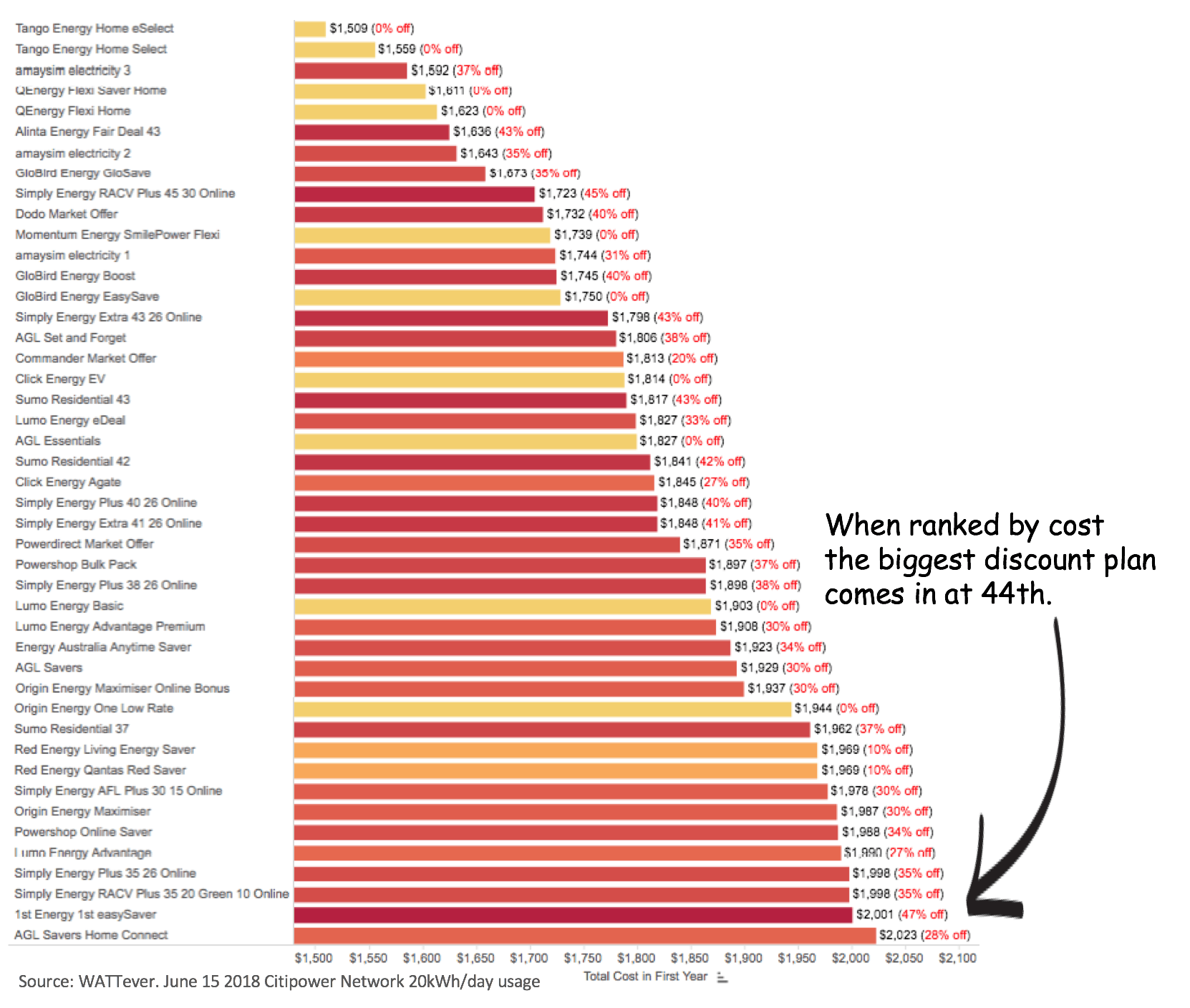When trying to save money many people look for the biggest electricity discount plans on offer. They figure it’s an easy way to find the best ‘deal’. The trouble is when it comes to electricity you can’t compare offers based on the discount rate and expect to find the cheapest plan for your situation.
This article was written in June 2018 at the peak of the ‘made-up’ electricity discount war to slay the myth about some of the biggest discounts offer. Since then the National Energy Regulator (AER) and Victoria Essential Services Commission (ESC) stepped in and set rules about how energy discounts must be presented based on a set benchmark. From July 1 2019, a Reference Price has been established in each network for an average household. This is called the Default Market Offer aka DMO in NSW, SE Qld and SA and known as the Victorian Default Offer aka VDO elsewhere. The DMO/VDO is updated each year, and is a safety net offer for customers not already on market plans. Any quoted discounts MUST BE STRICTLY calculated off the DMO/VDO price.
Of course – discounts are only accurate if you use the exact same amount of power as the average household. Many people use a lot less or a lot more power. This matters, because supply and usage changes vary on each plan. For small energy users fixed supply charges can make a up a big portion of their bill, so plans with cheaper supply charges typically work out well, even if the usage costs are a little higher. In contrast, big energy users will benefit from lower usage charges even if the supply costs are a little higher. Throw solar into the mix and it’s a whole different game. As a result, the best deal for your unique situation can only be accurately estimated with a proper comparison.
The discount distraction
Which would you prefer? An electricity plan with a 30% discount on your bill or another plan that offers a 0% discount. I never pay full price – the 30% discount must be cheaper, right? Only if you wrongly assume that the price for electricity is the same between retailers and plans. It’s not. The price of electricity varies wildly. That’s because electricity retailers are free to set their own base rates. Some retailers simply increase their base rates and inflate the discount percentage to make it look like they are offering a better deal. As the market has become more competitive, this practice has proliferated across retailers.
The fake discount war of 2015-2018
Over the last three years, while actual electricity prices have sky-rocketed, the ‘made-up’ discount levels on offer have hit new heights. In order to compete in the eyes of potential customers who buy based on the discount rate and not the actual post-discount price, retailers feel they have to promote even bigger discounts. Victoria is at crazy levels, NSW is now up to 42% discounts with SA and QLD not far behind. We all know that the first casualty of war is the truth. There are big discounts attached to plans that aren’t remotely competitive. Let me illustrate this with a real example of why a big discount % on a plan doesn’t assure you’re on a great deal.
The discount myth busted
Victoria was the first contestable state for electricity. Discounting has gone ballistic with retailers in this market offering plans with up to 47% discounts. Let’s look at the real numbers. The chart below ranks the cheapest publicly-listed electricity plans available in the second week of June 2018 in the CitiPower network (in Melbourne), for an average household using 20kWh of power a day. The biggest electricity discount plan is 1st Energy’s 1st easySaver offering. This plan has a massive 47% discount. Sounds good? Astoundingly, there are forty-three plans that would leave you better off than the 1st easySaver plan. The annual cost of $2,001 is almost $500 more than the cheapest plan. To be fair there are many other big discount plans that are way off the money. The point here is that there is simply no correlation between discount and cost.
The cheapest available plan in this example has an annual cost of $1,509. You’ll notice that there’s no discount on the cheapest plan. In fact, it just so happens that four of the top five plans at this time, were zero discount plans. You can read the discount rate in red after the cost and you’ll note that the bars are colour coded based on % discount – becoming dark red for the highest discount plans. The result – there’s no correlation between discount level and cost. When you can see things clearly it’s easy to ignore the things that don’t matter.
Just looking at discount level won’t help you find the best deal
My point is the cheapest plans have the lowest costs. Full stop. They might or might not have a discount.
Don’t waste a moment thinking about the discount – and getting pulled off track. The size of the discount simply doesn’t matter. The only way to find the best deal is to properly calculate which plans offer the lowest costs. At WATTever we’re obsessive about comparing the right way so you can see for yourself where you’ll find genuine value.

